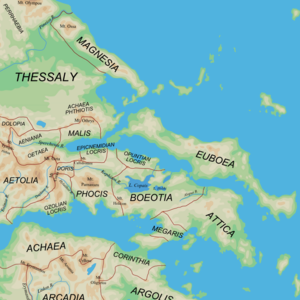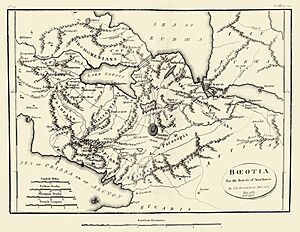Boeotia facts for kids
Quick facts for kids
Boeotia
Περιφερειακή ενότητα
Βοιωτίας |
|
|---|---|

Municipalities of Boeotia
|
|
| Country | Greece |
| Administrative region | Central Greece |
| Area | |
| • Total | 3,211 km2 (1,240 sq mi) |
| Population | |
| • Total | 106,056 |
| • Density | 33.029/km2 (85.545/sq mi) |
| Time zone | UTC+2 (EET) |
| • Summer (DST) | UTC+3 (EEST) |
| Postal code |
32x xx, 190 12
|
| Area code(s) | 226x0 |
| Vehicle registration | ΒΙ |
Boeotia (pronounced bee-OH-shee-uh) is a region in Greece. It is known as a "regional unit" today. It is part of Central Greece. The main city and capital of Boeotia is Livadeia. The largest city is Thebes. Boeotia was also an important area in ancient Greece for many centuries.
Contents
Exploring Boeotia's Geography
Boeotia is located north of the eastern part of the Gulf of Corinth. It also has a small coastline on the Gulf of Euboea. It shares borders with other regions. These include West Attica to the south and Attica to the southeast. To the northeast is Euboea. Phthiotis is to the north, and Phocis is to the west.
Mountains and Rivers in Boeotia
The main mountains in Boeotia are Mount Parnassus in the west. You can also find Mount Helicon in the southwest. Cithaeron is in the south, and Parnitha is in the east. The longest river is the Cephissus. It flows through the central part of the region. Most of Boeotia's flat, low areas are found here.
Lakes of Boeotia
Lake Copais was once a very large lake in central Boeotia. It was drained in the 1800s. Another big lake, Lake Yliki, is located near Thebes.
The Ancient Origins of Boeotia
The name "Boeotians" might come from a mountain called Boeon in Epirus. The first people to live in Boeotia were called Minyans. They were linked to the city of Orchomenus. Ancient writers say the Minyans founded the city of Teos. They also lived on the islands of Lemnos and Thera. Sometimes, the famous Argonauts were called Minyans.
Early Wealth and Power
Boeotia was very rich and powerful in ancient times. This is shown by the impressive remains of Mycenaean cities. These include Orchomenus and Thebes. The Boeotians were related to the Thessalians. They spoke a similar dialect called Aeolic. It is believed that the Boeotians originally lived in Thessaly. This was the largest fertile plain in Greece. They later moved south to Boeotia.
Legends and Literature from Boeotia
Many famous ancient Greek legends started or are set in Boeotia. These myths became popular during the Mycenaean Age (1600–1200 BC). During this time, Thebes became a very important city. Many legends are connected to Argos. Others show links to Phoenicia, where Greek traders set up posts.
Famous Boeotian Legends
Important legends from Boeotia include:
- Eros, the god of love, was worshiped in Thespiae.
- The Muses, goddesses of inspiration, lived on Mount Helicon.
- The story of Ogyges and a great flood.
- Cadmus, who founded Thebes and brought the alphabet to Greece.
- The gods Dionysus and Semele.
- Narcissus, who fell in love with his own reflection.
- Heracles, the strong hero, was born in Thebes.
- The Theban Cycle, which includes myths about Oedipus and the Sphinx. It also tells of the Seven against Thebes.
- Antiope and her sons Amphion and Zethus.
- Niobe, who cried so much she turned to stone.
- Orion, a giant hunter born in Boeotia.
Boeotia in Greek Plays
Many of these legends were used in plays by famous Greek writers. These include Aeschylus, Sophocles, and Euripides.
- Aeschylus wrote Seven Against Thebes.
- Sophocles wrote Oedipus Rex, Oedipus at Colonus, and Antigone. These are known as the Theban plays.
- Euripides wrote Bacchae, Phoenician Women, Suppliants, and Heracles.
Boeotia was also home to an ancient oracle. This was the shrine of Trophonius at Lebadea. The ancient city of Graea in Boeotia might be where the word Greece comes from. Famous poets like Hesiod and Pindar were from Boeotia.
A Look at Boeotia's History

Boeotia was very important politically. This was because of its location on the north shore of the Gulf of Corinth. Its borders were strong, and it was easy to travel within the region. However, it did not have good harbors. This slowed its development as a sea power.
The early people of Boeotia were the Minyae. Their importance is shown by archaeological finds. These include the "Treasury of Minyas." The Boeotian people arrived from the north. They may have come before the Dorian invasion. The original people were soon mixed with these newcomers. From then on, the Boeotians were a united group. They spoke Aeolic Greek.
The Rise of Thebes
In historical times, Thebes was the leading city of Boeotia. Its central location and military strength made it a good capital. Other important towns were Orchomenus, Plataea, and Thespiae. Thebes always wanted to unite all the other towns into one state. This was similar to how Athens united the communities in Attica. But the other cities resisted this idea. They only agreed to form a loose group that was mostly religious.
The Boeotians usually worked together against foreign enemies. However, the constant fighting between their own cities slowed their progress. Boeotia did not become very famous in history until the late 500s BC. Before this, they were mainly known for their unique pottery. In 519 BC, Plataea resisted Thebes' plan to unite the cities. This led to Athens getting involved. Athens defeated the Boeotians in 507 BC.
Boeotian Economy and Society
The book Works and Days by Hesiod tells us a lot about Boeotia's economy. Hesiod lived in Boeotia. He describes how a modern economy began to develop. People started using skilled workers to make tools. Sea trade also became more important.
The Boeotian League
In 395 BC, the Boeotian League was a group of eleven independent cities and their towns. Each group chose one "Boeotarch." This person was like a minister for war and foreign affairs. Each group also sent sixty representatives to the main council in Thebes. They also provided soldiers for the army. Thebes provided two Boeotarchs. By 395 BC, Thebes provided four. This included two from places it had taken over, like Plataea.
The total army of the Boeotian League was about 11,000 foot soldiers and 1,100 horsemen. Historians use these numbers to guess the population of Boeotia. Some estimates suggest the total population was around 165,500 people.
Boeotia in the Persian and Peloponnesian Wars
During the Persian Wars in 480 BC, Thebes helped the invaders. Because of this, Thebes lost its leadership in the Boeotian League for a while. But in 457 BC, the Spartans helped Thebes regain its power. They wanted Thebes to be a strong defense against Athens. Athens fought back and took control of Boeotia for ten years. But in 447 BC, the people revolted and won their freedom back.
In the Peloponnesian War, the Boeotians strongly fought against Athens. They helped at Syracuse and in the Battle of Arginusae. Their greatest victory was at the Battle of Delium in 424 BC. Their soldiers and cavalry fought very well.
Later History and Decline
Boeotia played a big part in the Corinthian War against Sparta. This was mainly because people were tired of outside interference. But there was also growing unhappiness with Thebes. Sparta encouraged this feeling. In 374 BC, Pelopidas helped Thebes become powerful again. Boeotian soldiers fought in all the battles of Epaminondas against the Spartans. This included the famous Battle of Leuctra in 371 BC.
After the Battle of Chaeroneia, Boeotia never became as strong again. The destruction of Thebes by Alexander the Great in 335 BC ended Boeotia's political power. They no longer made their own policies. Instead, they followed the lead of stronger powers. The region suffered greatly during the First Mithridatic War.
Middle Ages and Modern Recovery
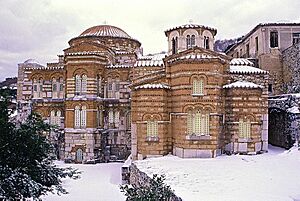
Boeotia remained in decline for a long time. There was a short period of success under the Frankish rulers of Athens (1205–1310). They fixed the drainage channels of Lake Kopais and helped farming. But the region continued to struggle. The first step towards recovery was in 1895. This is when the drainage channels of Kopais were fixed again.
Archaeological Discoveries in Boeotia
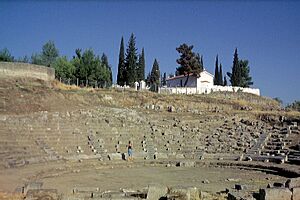
Between 1880 and 1886, Heinrich Schliemann dug at Orchomenus. He found a large tomb called the "Tomb of Minyas." This Mycenaean monument was as impressive as the "Treasury of Atreus" at Mycenae. Later, more excavations found an ancient temple and burials. Research continued in the 1970s. This uncovered a Mycenaean palace, an ancient cemetery, and an amphitheater.
How Boeotia is Governed Today
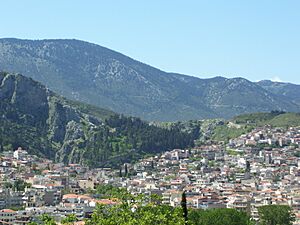
The regional unit of Boeotia is divided into 6 main areas called municipalities. These are:
- Aliartos-Thespies
- Distomo-Arachova-Antikyra
- Livadeia
- Orchomenos
- Tanagra
- Thebes (also called Thiva)
Changes in Administration
Boeotia became a "prefecture" in 1836. It was separated from the larger Attica and Boeotia Prefecture. This happened again in 1899 and 1943. In 2011, a government reform created the current "regional unit" of Boeotia. The municipalities were also reorganized at that time.
| New municipality | Old municipalities & communities | Seat |
|---|---|---|
| Aliartos | Aliartos | Aliartos |
| Thespies | ||
| Distomo-Arachova-Antikyra | Distomo | Distomo |
| Arachova | ||
| Antikyra | ||
| Livadeia | Livadeia | Livadeia |
| Davleia | ||
| Koroneia | ||
| Kyriaki | ||
| Chaironeia | ||
| Orchomenus | Orchomenus | Orchomenus |
| Akraifnia | ||
| Tanagra | Tanagra | Schimatari |
| Dervenochoria | ||
| Oinofyta | ||
| Schimatari | ||
| Thebes (Thiva) | Thebes | Thebes |
| Vagia | ||
| Thisvi | ||
| Plataies |
Past Divisions: Provinces
In the past, Boeotia was divided into "provinces." These were:
Boeotia's Economy Today
Boeotia is an important industrial area in Greece. It is home to the third largest pasta factory in Europe, owned by MISKO. This company is part of the Barilla Group. Many other large companies have factories here. For example, Nestlé and Viohalco have factories in Oinofyta, Boeotia.
Transportation in Boeotia
Several important roads pass through Boeotia:
- Greek National Road 1/E75 (southeast, east, northeast)
- Greek National Road 3 (south, east, central, west, northwest)
- Greek National Road 27 (west, southwest)
- Greek National Road 44 (east)
- Greek National Road 48 (west)
Famous People from Boeotia
Many important figures in history were born or lived in Boeotia. Some of them include:
- Epaminondas - a brilliant general and statesman.
- Hesiod - a famous ancient Greek poet.
- Pelopidas - another important general and statesman.
- Pindar - one of the greatest ancient Greek lyric poets.
- Plutarch - a well-known historian and biographer.
Images for kids
-
A Boeotian cup from Thebes painted with birds, from 560–540 BC.
See also
- Boeotian helmet
- Boeotian shield
- List of settlements in Boeotia
- Graïke




